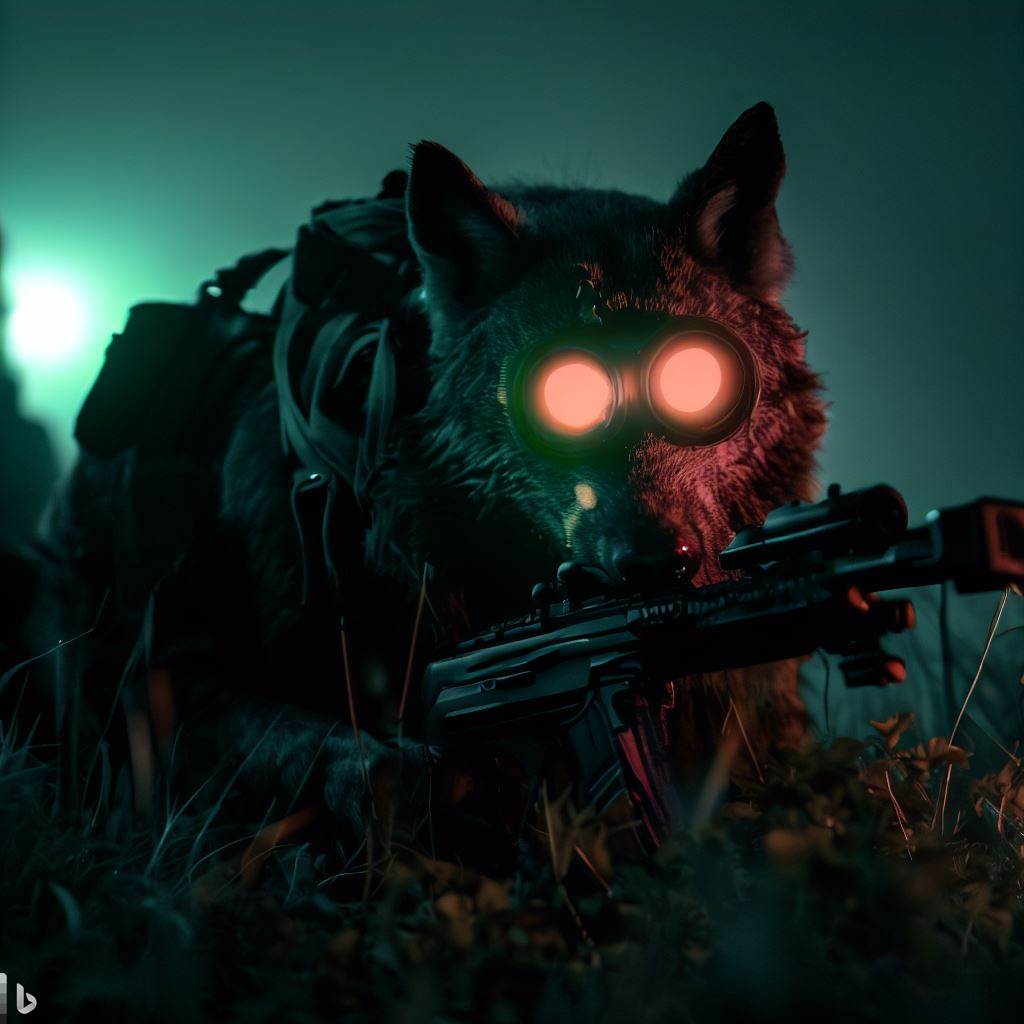

In the fascinating world of hunting, the use of night vision technology has become increasingly popular among hunters. However, a burning question remains: Do Animals React Differently To Hunters Using Night Vision Goggles?
This article explores the potential impact night vision may have on animal behavior, shedding light on the dynamic between predator and prey in the darkness of the night. Discover the surprising findings and gain a deeper understanding of how animals may perceive and respond to hunters in the realm of night vision.
1. Introduction
When it comes to exploring the darkness, humans have always been at a disadvantage compared to other animals. However, with the advent of night vision technology, the playing field has been leveled to some extent. Night vision devices have become increasingly popular among hunters, allowing them to navigate through the darkness with enhanced visibility.
But how do animals perceive this technology? Do they react differently to hunters using night vision? In this article, we will delve into the fascinating world of animal vision in the dark, discuss the impact of night vision hunting on animal behavior, explore the factors influencing animal responses, and consider the ethical considerations associated with the use of this technology.
We will also explore strategies to minimize disturbance and discuss alternatives to night vision hunting.
2. Understanding Night Vision Technology
2.1 How does night vision work?
Before we can dive into the impact of night vision hunting on animals, it’s important to understand how this technology works. Night vision devices amplify the available light, allowing for improved visibility in low-light conditions. The most common night vision technology is image intensification, which works by capturing ambient light through an objective lens and converting it into electrons.
These electrons are then amplified and sent to a phosphor screen, where they create a visible image. This process happens in real-time, providing hunters with a clear view of their surroundings even in the darkest of nights.
2.2 Types Of Night Vision Devices
There are several types of night vision devices available on the market, each offering its own set of advantages and limitations. The most common types include:
-
Night Vision Goggles: These devices are worn on the head, allowing users to have stereoscopic vision in the dark. They are versatile and suitable for various activities, including hunting.
-
Night Vision Binoculars: Similar to goggles, night vision binoculars provide stereoscopic vision but with the added benefit of magnification. They offer a wider field of view, making them ideal for scouting and spotting targets.
-
Night Vision Riflescopes: These devices attach to firearms and provide enhanced visibility for precise shooting in low-light conditions. They often come with features such as built-in rangefinders and ballistic calculators.
-
Thermal Imaging Devices: Unlike traditional night vision technology, thermal imaging devices detect heat signatures rather than amplifying light. They create an image based on differences in temperature, allowing hunters to detect animals even in complete darkness.
3. Animal Vision in the Dark
3.1 How Do Animals See In The Dark?
Animals have adapted various strategies to see in the dark, and their visual systems differ greatly from humans. Many nocturnal animals have specialized anatomical structures and an increased number of light-sensitive cells in their eyes, such as rods.
The presence of a tapetum lucidum, a reflective layer behind the retina, also enhances their night vision by reflecting incoming light back through the photoreceptors, maximizing the use of available light.
3.2 Differences Between Human And Animal Night Vision
While humans can improve their night vision to some extent with the help of night vision devices, it is important to note that animals have evolved to naturally excel in low-light conditions. The differences in their visual systems allow animals to detect subtle movements and details that might go unnoticed by humans, even with the aid of technology.
This heightened ability to perceive movement and sense potential threats can significantly impact their response to hunters using night vision devices.
4. Impact of Night Vision Hunting on Animal Behavior
4.1 Startling Reaction
The use of night vision technology by hunters can elicit different responses from animals. One common reaction is a heightened startle response when animals detect the presence of humans equipped with night vision devices. The sudden appearance of illuminated figures in the darkness can be alarming and cause animals to flee or exhibit other defensive behaviors.
4.2 Increased Vigilance
Night vision hunting can also result in animals becoming more vigilant. They may be aware of the hunter’s presence and exhibit hypervigilance, constantly scanning their surroundings and being on high alert. This increased vigilance can make it more challenging for hunters to approach animals without being detected.
4.3 Changes In Feeding And Foraging Behavior
The presence of hunters using night vision technology can disrupt the feeding and foraging behaviors of animals. They may alter their activity patterns, reducing their foraging time or changing their feeding locations to avoid potential encounters with hunters.
This disruption to their natural behavior can have long-term effects on their overall health and habitat utilization.
4.4 Alteration Of Migration Patterns
Night vision hunting can also impact animal migration patterns. The disruption caused by the presence of hunters may lead animals to alter their traditional migratory routes or delay their travel to minimize the risk of encountering potential threats. These alterations in migration patterns can have cascading effects on ecosystems and wildlife populations.
4.5 Disruption Of Mating And Breeding Activities
The use of night vision technology in hunting can disrupt mating and breeding activities of various species. Animals may avoid traditional mating grounds or change their reproductive behaviors to reduce the risk of encounters with hunters. This can ultimately impact population dynamics and genetic diversity within the species.
5. Factors Influencing Animal Responses
5.1 Species-specific traits
Different species of animals may react differently to hunters using night vision technology due to their varying evolutionary adaptations and behaviors. Some species may have developed specific strategies to avoid predators, while others may be more tolerant or accustomed to human presence.
5.2 Size And Proximity Of The Hunting Party
The size and proximity of the hunting party can also influence animal responses. Animals may be more cautious and exhibit stronger avoidance behaviors if they perceive a larger group of hunters using night vision technology.
The distance between the hunters and the animals can also impact the degree of disturbance experienced by the animals.
5.3 Frequency Of Hunting Activities
The frequency of hunting activities in an area can influence animal responses. Repeated exposure to night vision hunting may result in habituation, where animals become less responsive or more tolerant to the presence of hunters. Conversely, infrequent hunting activities may have a stronger disruptive effect on animal behavior.
5.4 Location And Habitat
The location and habitat where night vision hunting occurs can also influence animal responses. Some habitats may provide more cover and hiding opportunities for animals, allowing them to evade detection more effectively. Additionally, animals in areas with higher hunting pressure may exhibit different behavioral adaptations compared to those in less hunted areas.
5.5 Time Of Year And Weather Conditions
The time of year and weather conditions can impact animal responses to night vision hunting as well. During breeding seasons or periods of food scarcity, animals may be more sensitive to disturbances and exhibit stronger avoidance behaviors.
Similarly, adverse weather conditions, such as heavy rain or strong winds, may limit the effectiveness of night vision devices and reduce the impact of hunting activities.
5.6 Previous Exposure To Human Presence
Animals that have been exposed to human presence, either through hunting or other human activities, may react differently to night vision hunting. They may have learned to associate human presence with potential threats and exhibit stronger avoidance behaviors.
On the other hand, animals with limited exposure to humans may be more naive and susceptible to disturbances caused by hunters using night vision devices.
6. Ethical Considerations
6.1 Debate On The Use Of Night Vision Technology In Hunting
The use of night vision technology in hunting has sparked ongoing debates regarding its ethical implications. Some argue that it provides an unfair advantage to hunters, disrupting the natural balance between predator and prey. Others contend that it allows for more efficient and selective hunting practices, reducing the overall suffering of animals.
6.2 Impact On Animal Welfare
The impact of night vision hunting on animal welfare is an important ethical consideration. The stress and disturbance caused by hunters using this technology can have negative consequences on animal well-being. It is crucial to assess the level of disturbance and identify ways to minimize any potential harm inflicted on animals during hunting activities.
6.3 Conservation Implications
The conservation implications of night vision hunting should also be taken into account. Hunting plays a role in wildlife management, and the use of night vision technology can potentially disrupt natural behaviors and population dynamics.
Balancing the need for effective wildlife management with ethical considerations is essential for maintaining healthy ecosystems and biodiversity.
7. Strategies To Minimize Disturbance
7.1 Use Of Camouflage And Scent Control
Hunters can minimize disturbance to animals by employing effective camouflage techniques and using scent control measures. Selecting appropriate camouflage patterns that blend with the surrounding environment can make hunters less conspicuous to animals.
Additionally, minimizing human scent through the use of scent-masking sprays or scent-eliminating clothing can help reduce the chances of animals detecting the presence of hunters.
7.2 Implementing Hunting Restrictions And Regulations
The implementation of hunting restrictions and regulations can also help minimize disturbance to animals. Setting limits on the number of hunters allowed in specific areas and imposing restrictions on hunting practices can help mitigate the overall impact of night vision hunting on wildlife populations. These regulations should aim to balance the needs of hunters with the conservation of animal welfare.
7.3 Promoting Sustainable Hunting Practices
Promoting sustainable hunting practices is crucial for minimizing the negative impact of night vision hunting. Hunters should be encouraged to harvest animals responsibly, only targeting species within sustainable population levels. This can help ensure the long-term viability of wildlife populations and the ecosystems they inhabit.
8. Alternatives to Night Vision Hunting
8.1 Traditional Hunting Methods
While night vision hunting can provide hunters with improved visibility, traditional hunting methods can still be effective and less disruptive to animal behavior. Using stealth, patience, and knowledge of animal behavior, hunters can rely on their own senses and skills to track and harvest game without the use of technology.
8.2 Wildlife Photography And Observation
For those who want to experience the thrill of wildlife encounters without causing harm or disturbance, wildlife photography and observation provide excellent alternatives to night vision hunting. These activities allow people to appreciate and document the beauty of wildlife while minimizing the impact on their natural behaviors.
9. Conclusion
As night vision technology becomes increasingly accessible to hunters, the potential impact on animal behavior cannot be disregarded. Animals may react differently to the presence of hunters using night vision devices, altering their natural behaviors and disturbing delicate ecological balances.
Understanding the differences between human and animal night vision, as well as the factors influencing animal responses, is crucial for promoting ethical hunting practices and minimizing disturbance. By implementing strategies such as camouflage, scent control, hunting restrictions, and sustainable practices, we can strive to strike a balance between our desire to engage in night vision hunting and the ethical considerations regarding animal welfare and conservation.
Exploring alternatives like traditional hunting methods, wildlife photography, and observation can also provide opportunities for meaningful interactions with wildlife while respecting their natural habitats and behaviors.
Top Night Vision Goggles of 2023: Expert Reviews and Buying Advice
The Ultimate Guide to the Top 5 Night Vision Binoculars for Hunting
Top 5 Night Vision Monoculars for Hunting in 2023 | Best Rating
How Do I Minimize Noise When Using Night Vision For Hunting?





